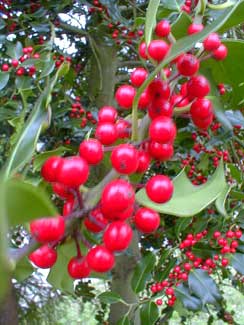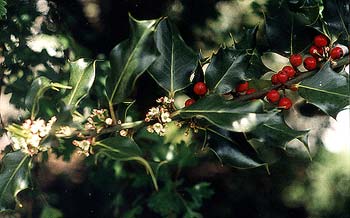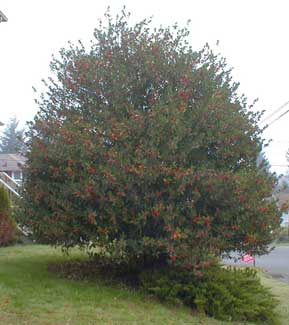 Holly Tree
Holly Tree
"As the holly groweth green
And never changeth hue,
So I am, ever hath been
Unto my lady true."
-Green Groweth the Holly
by Henry VIII
(1491-1547)
by Henry VIII
(1491-1547)
The big holly tree in the front yard was a holy terror when we first bought the house, with its long limbs of hard sharp leaves hanging low over the yard where easily run into, & shedding sharp leaves to harm a bare foot & making it dangerous to sit on the grass anywhere nearby.
When we first bought the house we rejected a passing notion of cutting it down, but it was such a killjoy stabbing us all the time, & what was worse, to one side of it stood a large hawthorn tree with nasty spikes sticking out of the trunk & every limb, & crowded in the same area was an old firethorn bush with four inch spines (that has since been removed for lack of room, everything having grown so large), so that it was impossible to garden in the area without being injured by something or another.
 One day I decided to underlimb the holly & the hawthorn. I stripped the first six or eight feet of the holly's trunk of all its branches, & sheered back some higher branches that shed harsh leaves in the grass. Though fearful I'd make it ugly, in fact it looked much better with its trunk visible. So what at first seemed a nuisance had become an asset with its stunning evergreen leaves & its brightest-bright red berries. The photo of the holly branch at the top of the page is from December. There are more portraits of the berries on the Holly Page of the Berries Gallery.
One day I decided to underlimb the holly & the hawthorn. I stripped the first six or eight feet of the holly's trunk of all its branches, & sheered back some higher branches that shed harsh leaves in the grass. Though fearful I'd make it ugly, in fact it looked much better with its trunk visible. So what at first seemed a nuisance had become an asset with its stunning evergreen leaves & its brightest-bright red berries. The photo of the holly branch at the top of the page is from December. There are more portraits of the berries on the Holly Page of the Berries Gallery.But after six years, with all nearby trees getting bigger & bigger, including a Douglas fir crowding the holly, I topped the holly by half & removed most of its limbs. It's now a wreck of a tree but I like its tortured look reduced to an understory broken tree.
Truncating a tree that severely will almost certainly shorten its life. I'd actually intended to cut down the rest of it but it looked so interestingly rustic as half a tree, as if a storm had snapped it in half, that I decided to keep it a few more years. I unlimbed it on the garden side so that it grows exclusively into the morning sun overhanging the sidewalk. It quickly produced new shrubby limbs & continues to fruit & flower superbly. I will likely take the rest of it down eventually, if it ever again begins to compete too much with the fir & the hawthorn that flank it. But for now it functions as attractive filler, as an extremely fat-trunked shrub.
And if I ever miss having a big holly tree, I only have to look straight across the road at Pam's & Long's house, where she has a very nice holly shown in the third photo below. Pam's tree has been "undersheered" so that its limbs do not quite touch the ground, but not underlimbed. I've suggested she put an autumn cyclamen garden in the space beneath, as it would be the perfect location for C. hederifolium though little else would ever grow in such a spot. But so far she hasn't bothered to do so.
 The English Holly I. aquifolium has ever such brighter berries than the American Holly I. opaca. New berries ripen in Autumn & linger until the following spring or even into summer. Although wildlife will occasionally regard the holly berries as acceptable winter fare, for humans they are toxic.
The English Holly I. aquifolium has ever such brighter berries than the American Holly I. opaca. New berries ripen in Autumn & linger until the following spring or even into summer. Although wildlife will occasionally regard the holly berries as acceptable winter fare, for humans they are toxic.Several types of dreadful-tasting berries such as hawthorn, firethorn, manzanita, Oregon Grape, & many varieties of Viburnum including Highbush Cranberry, are eaten by wildlife after they've gone through a few frosts, as the frost sweetens them up considerably. Most such berries are equally edible for people if cooked, with the seeds sieved out of them, & the pulp spiced & sweetened for jellies or sauces. But I have not been able to discover whether it would ever be safe to do this with holly berries. No edible berry resource I've checked is willing to suggest the toxins would be cooked out of holly entirely, & most strongly warn against them.
Nevertheless, whether or not wisely, a tincture or tea made from the berries & leaves has long been regarded as a cure for high fever, jaundice, rheumatism, gout & all sorts of other complaints. Whether or not it really has these medicinal properties is uncertain, though it does at the very least work as an astringent, expectorant, or purgative, with a high potential for harm so that it is not the safest bit of folkloric wisdom to incorporate into one's list of favorite herbal swills.
The famed but frankly crackpot English herbalist Nicholas Culpepper (1616-1654) recommended English holly berries be taken as one would take pills to cure colic, induce sobriety, purge the body of unhealthful waste, & to induce flatulance. It might be unpleasant to have Culpepper to one's home as company, for he regarded farting to be a good & healthy practice to be soundly encouraged!
There are other holly varieties that are appropriate for brewing beverages, but as for English Holly, it remains that the berries & seeds are toxic. As few as two English Holly berries may prove sufficient to induce stomach pain, nausea, vomiting, or diarrhea.
The toxic compounds of English Ivy consist of saponin, phenols, terpenoide, sterols, theobromine, & anthocyanine. If a child ate between five & ten berries, that child could well behave as if intoxicated or extremely drowsy, & an emergency trip to the hospital for gastric lavage would be a reasonable response.
However, the berries taste so awful there's really not much chance of successfully chewing up more than one, & even the one would be quickly spat out. Severe illness from holly berries is almost unheard of, or they wouldn't be permitted their omnipresence as winter decorations indoors. But quite obviously, children should be warned never to eat them.
The holly tree blooms in May, when the previous year's big bright berries & the new spring's small white blooms share the branches, as shown in the second photo. In June it's still loaded with last year's berries, while new green ones are forming. By the time it loses it's previous year's fruits, a new batch are well started.
This tree can grow 30 or 50 feet high or higher. Ours was 20 or 25 feet before I took half of it down; Pam's is about 18 or 20 feet high now. Holly is densely foliaged when in bright sun. Holly does well in shade as well, but will not be so compactly leafed. The trees usually do not produce berries until they're two decades old, though many cultivated large shrub varieties can be had which will bloom when young.
Only the female tree produces berries of course, & only if pollinated by a male. There are several hollies in the neighborhood, & obviously one of the males is close enough to reach the female with his pollen, since our truncated tree & Pam's intact one both fruit so extravagantly.
There are self-seeded offspring hollies & Douglas firs all about our neighborhood's hill. If our holly tree hadn't been growing ridiculously close to a Douglas fir, I wouldn't've interferred with it continuing as a large tree in a small yard. Both it & the fir are on the very ledge of a cliff wall, where no one was apt to have planted either tree intentionally, & it's 99.9% probable that both trees volunteered for the location two or three decades ago.
Myths & Legends of the Holly Tree